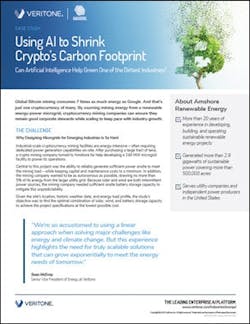How artificial intelligence can green the cryptocurrency industry
Cryptocurrency mining is one of the dirtiest industries there is, according to a new white paper from Veritone. The paper says that mining for Bitcoin alone, just one of many popular cryptocurrencies, consumes seven times the total amount of energy used by Google for all of its operations. This presents an enormous challenge: How can mining operations be both good corporate stewards and keep pace with industry growth?
The answer, Veritone says, is artificial intelligence (AI). In this paper, Veritone explains how Amshore Renewable Energy used AI and machine learning to inform the design of a 249-MW renewable energy microgrid for a cryptomining client. “Central to this project was the ability to reliably generate sufficient power on-site to meet the mining load — while keeping capital and maintenance costs to a minimum,” the paper says.
The customer wanted to draw only minimal energy from the grid, so a battery storage system was also included in the project’s specifications.
It’s amazing that a machine can do in minutes what it normally takes human engineers weeks to do. And it’s not just speed. These forecasts and simulations are bankable, which allows us to develop sustainable microgrid projects with much greater confidence. — Veritone, “Using AI to Shrink Crypto’s Carbon Footprint“
Artificial intelligence in the form of Veritone’s iDERMS Designer was used to run thousands of simulation models to find the “ideal balance of on-site renewable energy generation and storage to ensure the cryptocurrency mining company could achieve its sustainability, investment and operational targets.” The paper outlines some of the historic and real-time data points used in those simulations.
AI-powered simulation models were also used to illustrate how design decisions would impact the overall feasibility, cost and return on investment of the microgrid project — helping the customer to “understand the trade-offs between cost, grid independence and reliability.”
The paper includes key takeaways from the project about total cost inflection points and the impact of completely removing all connection to the grid.
Download the white paper for free from the Microgrid Knowledge white paper library.
About the Author
Kathy Hitchens
Special Projects Editor
I work as a writer and special projects editor for Microgrid Knowledge. I have over 30 years of writing experience, working with a variety of companies in the renewable energy, electric vehicle and utility sector, as well as those in the entertainment, education, and financial industries. I have a BFA in Media Arts from the University of Arizona and a MBA from the University of Denver.

